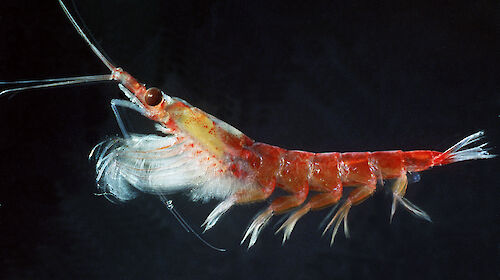The Australian Antarctic Division will attempt to fly thousands of live krill from Antarctica to Australia for the first time.
Scientists are trialling an aerial transport method using the Royal Australian Air Force (RAAF) C-17A Globemaster III to transport 10,000 krill in containers from Wilkins Aerodrome, near Australia’s Casey research station, to Hobart.
Antarctic Division krill biologist, Rob King, said it could potentially be as little as a day and a half from when the krill are caught in the Southern Ocean, to being in the aquarium in Hobart.
“This is the first time anyone has attempted to fly krill back from Antarctica,” Mr King said.
“It will provide a wonderful opportunity to undertake research on krill in prime condition, and particularly females, which are laden with eggs.”
The krill will be collected from Australia’s icebreaker Aurora Australis, near Casey research station, and put into four 1,000 litre containers.
The containers will then be loaded onto a barge and transferred by sled to Australia’s Wilkins Aerodrome.
“The tanks will be pumped full of oxygen and wrapped in a thermal blanket so they won’t freeze on the two-hour journey across the ice cap, where temperatures can drop as low as minus 30 degrees,” Mr King said.
“Once loaded onto the C-17A they’ll fly the 4.5 hours back to Hobart and then be transported by truck to the Division’s aquarium.
“Using eggs direct from the Southern Ocean for our research will give us a clearer and more accurate picture of what’s actually happening in wild populations.”
Australian Antarctic Division Operations Manager, Robb Clifton, said the trial flight was a great example of how Australia’s Airlink, now boosted through the support of the C-17A, can enable scientific research in Antarctica.
“As well as providing essential cargo and supplies to Australia’s Antarctic stations, the C-17A is providing scientists with direct access to the ice and the ability to transport samples, like live krill, back to Australia,” Mr Clifton said.
Krill that are caught in the Southern Ocean for research can take up to 6 weeks to return to Australia on the Aurora Australis.
“It will be a logistical challenge to coordinate the ship and plane, and to keep the krill alive on the journey back, but if we can transport the krill safely it will contribute to important research,” Mr Clifton said.
Antarctic Krill are the keystone species of the Southern Ocean ecosystem. They feed on a wide variety of southern ocean phytoplankton and zooplankton and are themselves prey for larger animals such as whales and seals and penguins.






